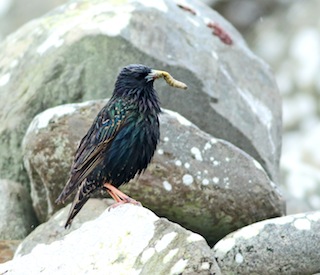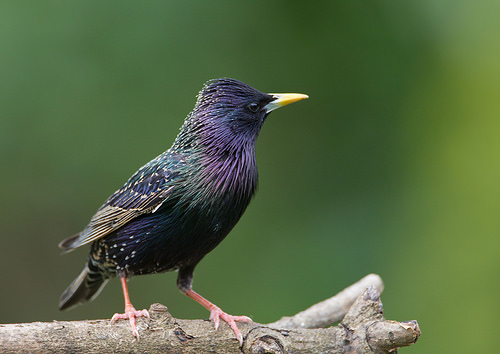 The glossy plumage of a starling is beautiful to see on a crisp autumn day on the Lizard. In the autumn, you can see the amazing spectacle of a starling murumuration – Poldhu is a good spot.
The glossy plumage of a starling is beautiful to see on a crisp autumn day on the Lizard. In the autumn, you can see the amazing spectacle of a starling murumuration – Poldhu is a good spot.
Photo: © Natural England/Allan Drewitt
Scientific name: Sturnus vulgaris
Other common names: Common Starling, European Starling
Cornish name: Troos
Conservation status: UK Birds of Conservation Concern, Red; IUCN Red List, Least Concern
What to look for:
- Colouring and appearance: Black with glossy purple-green plumage and white flecks. Pink legs. Bill black in winter, but yellow in summer, when the male bill also develops a blue tinge at its base.
- Size: Length 19 to 22 cm, wingspan 40 cm.
- Where: Everywhere, other than the most elevated regions in Scotland.
- Call: Listen to their distinctive song. Starlings are also well-known for their ability to mimic the song of other birds.
- Similar species: Blackbird. From a distance, Starlings seem black, but whereas male Blackbirds are black, Starlings have a glossy purple and green white-speckled plumage. They are also smaller than Blackbirds.
 Everyone knows Starlings. One of our most common garden birds, they are noisy, confident, and even belligerent at the bird table. A flock of starlings can easily see off larger birds such as Woodpigeons. You might therefore be surprised to learn that they are on the Red List in the UK. While they may still be a familiar garden visitor, they have been suffering from an overall and severe decline across the wider countryside: in woodlands, there has been a decline of over 90%, and 66% on farmland since the 1980s. The main reason is likely to be a reduction in permanent pasture – one of the best foraging habitats for Starlings – as a result of agricultural intensification.
Everyone knows Starlings. One of our most common garden birds, they are noisy, confident, and even belligerent at the bird table. A flock of starlings can easily see off larger birds such as Woodpigeons. You might therefore be surprised to learn that they are on the Red List in the UK. While they may still be a familiar garden visitor, they have been suffering from an overall and severe decline across the wider countryside: in woodlands, there has been a decline of over 90%, and 66% on farmland since the 1980s. The main reason is likely to be a reduction in permanent pasture – one of the best foraging habitats for Starlings – as a result of agricultural intensification.
With a distribution across Europe, Asia and Africa, the Starling can be seen in farmland, woods and towns across the UK, but is more abundant in the south. They eat invertebrates and seeds, and hunt for food by probing the soil with their pointed bill: leatherjackets are a big favourite. Males start to build their untidy twig and grass nests in the spring, usually placing them in a hole in a tree or building, but the female finishes the job. She often lines the nest with aromatic leaves. This isn’t because the scent is pleasant: the leaves increase the young birds’ chance of survival by boosting their immunity. Clutch size is usually between five and seven eggs. Both male and female share incubating and then feeding duties.
 The gregarious rabble of an individual Starling flock contributes to what is one of the UK’s most wonderful spectacles of nature: a murmuration. In the autumn and winter, individual flocks merge at the end of the day above reedbeds and farmland to form clouds of thousands of birds, wheeling and spiralling in unison. The sudden changes in direction, with all the birds moving as one, are breathtaking. These huge flocks are called a murmuration because of the sound of hundreds and thousands of wings as the Starlings swoop together. As night falls, the Starlings land to roost together for the night. The murmurations become even larger in winter, when they are joined by migrating birds from further north. So, what explains this behaviour? It is thought to be all about reducing predator risk. The birds are trying to fly as close together as they can and avoid being at the edge of the flock (where they are more vulnerable). They closely mimic neighbouring birds’ movements, with small changes then magnified through the entire murmuration to wonderful swirling effect.
The gregarious rabble of an individual Starling flock contributes to what is one of the UK’s most wonderful spectacles of nature: a murmuration. In the autumn and winter, individual flocks merge at the end of the day above reedbeds and farmland to form clouds of thousands of birds, wheeling and spiralling in unison. The sudden changes in direction, with all the birds moving as one, are breathtaking. These huge flocks are called a murmuration because of the sound of hundreds and thousands of wings as the Starlings swoop together. As night falls, the Starlings land to roost together for the night. The murmurations become even larger in winter, when they are joined by migrating birds from further north. So, what explains this behaviour? It is thought to be all about reducing predator risk. The birds are trying to fly as close together as they can and avoid being at the edge of the flock (where they are more vulnerable). They closely mimic neighbouring birds’ movements, with small changes then magnified through the entire murmuration to wonderful swirling effect.
Did you know…?
…Marathon birds: Starlings have evolved some clever adaptations for their lifestyle. One is their relatively long, stocky and strong legs, a perfect adaptation for a bird that is on its feet all day, foraging in the grass and soil for food.
…With a song in his heart: the wider and more complex the song repertoire of the male, the more success the male has in attracting a mate. The song increases in complexity as the bird gets older. It includes whistles and clicks, and songs copied from other birds, or even man-made sounds.

More information and references:
Svensson, L., Mullarney, K., Zetterstrom, D.,1986. Collins Bird Guide, second edition (translated by Christie, D., Svensson, L.). HarperCollins, London.
Published: September 2014
Author: Amanda Scott
Photos: Top (© Natural England/Paul Lacey); middle (Amanda Scott); bottom (© Natural England/Allan Drewitt)
